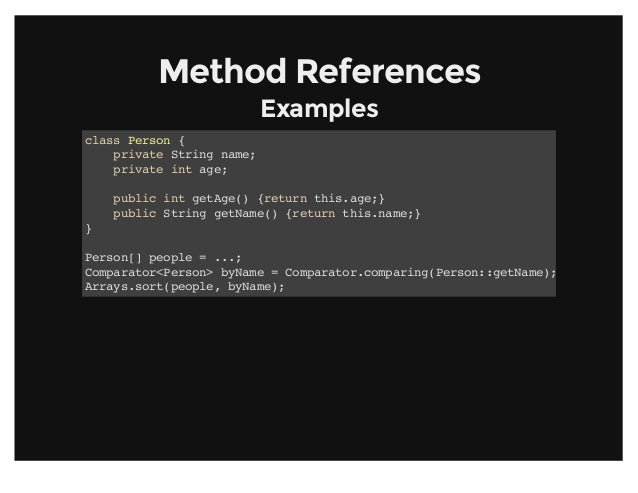Use Case
|
Example
|
Interfaces
|
Boolean
Expression
|
(List<String> list)
->list.isEmpty()
|
Predicate<List<String>>
|
New
Object
|
() -> new Apple(10)
|
Supplier<Apple>
|
Consume
Object
|
(Apple a) -> System.out.println(a.getWeight())
|
Consumer<Apple>
|
Retrieve
from Object
|
(String s) -> s.length()
|
Function<String, Integer>
/ ToIntFunction<String>
|
Combine
2 values
|
(int a, int b) -> a * b
|
IntBinaryOperator
|
Compare
2 Objects
|
(Apple
a1, Apple a2) ->
a1.getWeight().compareTo(a2.getWeight())
|
Comparator<Apple> / BiFunction<Apple, Apple, Integer> / ToIntBiFunction<Apple,
Apple>
|
Well, except for those interface above, I think most people have already known the static & instance method calling in java 8 is using :: symbol , for example :
But the :: symbol can also be used for creating new Object which is called method reference :
If Apple's Constructor signature is Apple(Integer weight),then Function should be used :
If Apple's Contructor has 2 paramters, then BiFunction should be used :
So In a word, those interfaces Supplier, Function, BiFunction only create a reference to certain constructors, and the creation of new object is done by those methods get and apply.
Well, most of the time , 2 params constructor encapsulation is enough , but what if 3, 4 .. params constructors are needed. Just define your interface like this :
And Use it similarly :
Ok, That's all about the method reference. I will cover most of the use cases in later articles.
(Apple a) -> a.getWeight() Apple::getWeight () -> Thread.currentThread().dumpStack() Thread.currentThread()::dumpStack (str, i) -> str.substring(i) String::substring (String s) -> System.out.println(s) System.out::println
But the :: symbol can also be used for creating new Object which is called method reference :
Supplier<Apple> c1 = Apple::new; Apple a1 = c1.get(); //== Supplier<Apple> c1 = () -> new Apple(); Apple a1 = c1.get();
If Apple's Constructor signature is Apple(Integer weight),then Function should be used :
Function<Integer, Apple> c2 = Apple::new; Apple a2 = c2.apply(110); //== Function<Integer, Apple> c2 = (weight) -> new Apple(weight); Apple a2 = c2.apply(110);
If Apple's Contructor has 2 paramters, then BiFunction should be used :
BiFunction<String, Integer, Apple> c3 = Apple::new; // point to the 2 params constructor Apple c3 = c3.apply("green", 110); // create a new Apple object // == BiFunction<String, Integer, Apple> c3 =(color, weight) -> new Apple(color, weight); Apple c3 = c3.apply("green", 110);
So In a word, those interfaces Supplier, Function, BiFunction only create a reference to certain constructors, and the creation of new object is done by those methods get and apply.
Well, most of the time , 2 params constructor encapsulation is enough , but what if 3, 4 .. params constructors are needed. Just define your interface like this :
public interface TriFunction<T, U, V, R>{ R apply(T t, U u, V v); }
And Use it similarly :
TriFunction<Integer, Integer, Integer, Color> colorFactory = Color::new;
Ok, That's all about the method reference. I will cover most of the use cases in later articles.


No comments:
Post a Comment